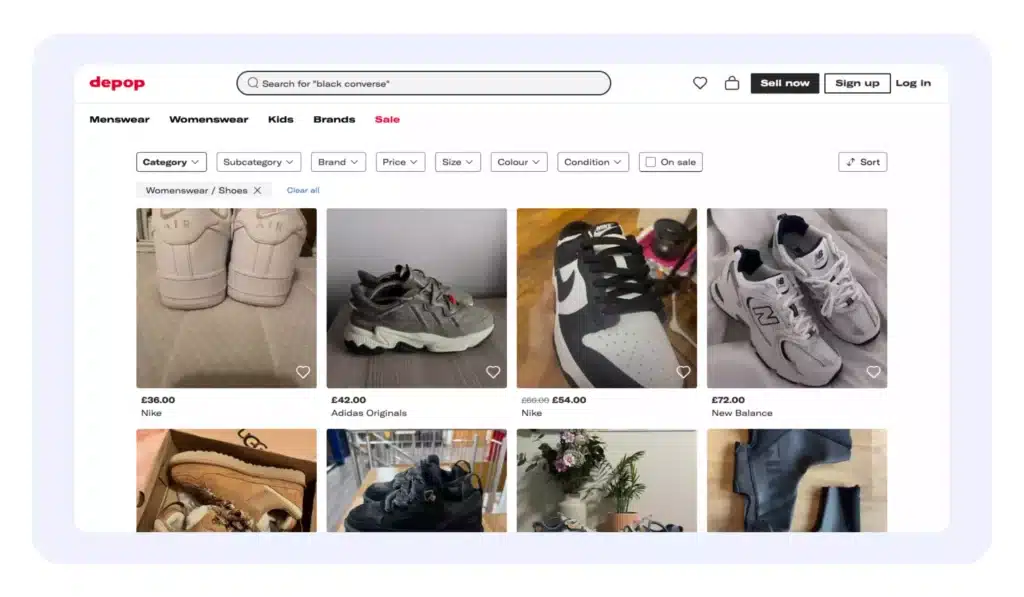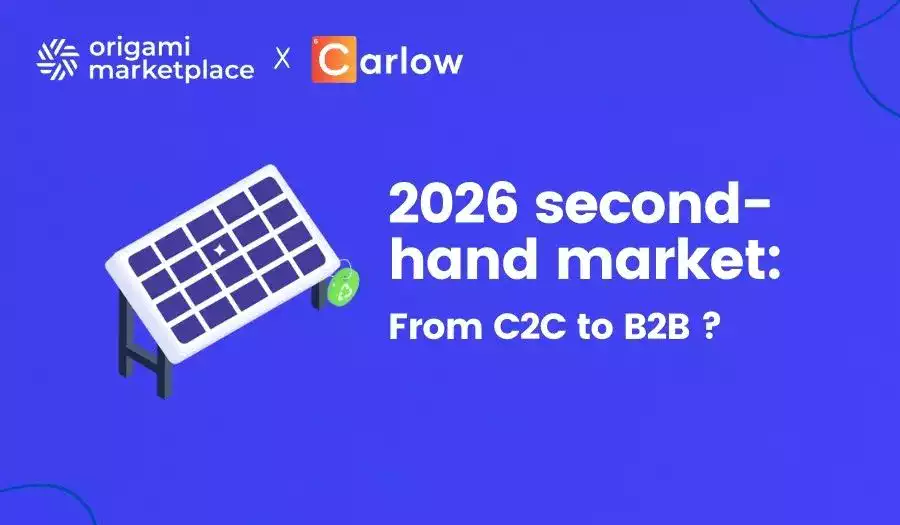How to create a website like Depop?
- Arnaud
- 6 minutes reading

In the evolving landscape of online commerce, Depop stands out as a trailblazer in combining vintage fashion, social interaction, and seamless peer-to-peer transactions. Its success lies in a strong sense of community, simple yet powerful features, and a clear monetization strategy. If you’re looking to create your own version of Depop where users can buy, sell, and connect over unique fashion finds this guide will walk you through the essentials.
From understanding Depop’s core pillars of success to choosing the right technology stack and marketing tactics, you’ll learn how to launch a thriving, socially-driven, second-hand marketplace that appeals to today’s conscious and trend-savvy consumer.
- What Is Depop?
- Why build a website Like Depop?
- The pillars of Depop’s success
- Key features of a Depop-like marketplace
- How Depop makes money
- How to create a website like Depop
- How much does it cost to build a Depop-like platform?
- Current trends in the second-hand and C2C market
- Launch your platform With Origami Marketplace
1. What is Depop?
Depop is a C2C (Consumer-to-Consumer) platform that blends e-commerce and social media. Founded in the UK, the app mainly targets Gen Z and millennials, allowing them to buy and sell fashion items: vintage clothing, independent designer pieces, unique accessories, and more.
Beyond simple transactions, Depop emphasizes social interaction: each user has a profile, can like or follow other members, comment, and send messages creating a dynamic community centered on sustainable fashion and creativity.
2. Why build a website like Depop?
Tap into the rapidly growing second-hand market: Consumers (especially younger generations) are increasingly drawn to second-hand items. They seek unique pieces, love the vintage aesthetic, and aim to reduce their environmental footprint. A Depop-like marketplace allows you to capture this expanding audience.
Leverage a dynamic C2C (Consumer-to-Consumer) model: Unlike a straightforward e-commerce site, a C2C marketplace thrives on community involvement. Users switch between being sellers and buyers, driving high engagement, frequent product turnover, and a strong sense of belonging. This social-media-like community aspect encourages user retention and organic growth.
Create value through circularity: As fast fashion faces growing criticism for its environmental impact, second-hand marketplaces stand out as ethical and cost-effective alternatives. By offering a space where users can resell or discover independent designer pieces, you support a circular economy and meet the needs of increasingly eco-conscious consumers.
Diversify your revenue streams: Depop-inspired marketplaces can monetize in various ways: sales commissions, buyer protection fees, premium visibility features, and brand partnerships. This diversified approach ensures sustainable profitability and helps you stay competitive, even in crowded markets.
Foster a community with a strong brand identity: Depop’s success lies in its unique, trend-driven, and inclusive environment that celebrates each user’s creativity. When building your own marketplace, you can establish a distinct brand persona (e.g., ethical fashion, vintage luxury, streetwear collectibles), attracting an engaged community that resonates with your core values.
3. The pillars of Depop’s success
Focus on alternative fashion and vintage: Depop identified and catered to younger consumers’ desire for original and eco-friendly pieces. With the second-hand and vintage market on the rise, Depop seized this trend and built a strong brand image.
Gamification and social features: The user experience on Depop is reminiscent of a social network. Features such as likes, follows, and in-app messaging create a strong sense of community. Users not only buy or sell, they explore, interact, and discover new trends through other members.
A simple and intuitive interface: Depop focuses on a mobile-first experience with an intuitive user journey. Quick sign-up, easy product listing, seamless communication between buyers and sellers. Everything is designed to streamline the buying and selling process.
A clear business model: Depop primarily makes money through a 10% commission on every sale. This straightforward model attracts both casual sellers and independent creators who see it as a channel to reach a relevant audience.
Ready to turn your B2B, B2C, or C2C marketplace vision into reality?
To help you develop the best platform possible, we’ve gathered all the must-have features, key technical considerations, and best practices in a comprehensive document:
Download the Specifications template 🗒
Perfect for smaller or medium-scale projects without a formal purchasing process. It will help you outline your requirements effectively and streamline your selection process.
Download the Request for Proposal template 📒
Ideal for larger, more complex marketplace projects with a formal purchasing department or advanced procurement policies.
4. Key features of a marketplace Like Depop
- Personalized user profiles: Each member can highlight their listings, add a short bio, and showcase their personal style.
- A product catalog: With powerful search and filtering options (categories, sizes, price range, brands, etc.) for easy browsing.
- Built-in messaging: To allow direct communication between buyers and sellers, negotiate prices, or ask questions about a product.
- Secure payment system: Ensuring user confidence and safe transactions, with various payment methods (credit card, PayPal, etc.).
- Social feed or news feed: Inspired by social media, letting users follow profiles, like, and comment on items to boost engagement.

5. How does a website like Depop make money?
Sales commissions: Depop charges a 10% fee on the total amount of each transaction (item price + shipping).
Service or buyer protection fees: Like Vinted, Depop may add fees for customer support or parcel protection.
Paid visibility options: Sellers can pay to promote their products or “shops” to appear more frequently in search results.
Premium or additional services: Some C2C platforms offer authentication services for luxury items, providing extra revenue streams while reinforcing buyer trust.
6. How to create a website like Depop
Define your positioning
- Decide if you want to focus on a niche (vintage, second-hand luxury, handmade items) or offer a broader range of products.
- Identify your unique selling proposition (USP) to differentiate yourself from competitors.
Choose the right technology
- No-code / Low-code: ideal if you have a limited budget and want to quickly test your idea.
- SaaS marketplace solutions: like Origami Marketplace, which offers ready-to-use features (product catalog, payments, dispute handling…).
- Custom development: more expensive, but allows for a fully tailored platform with complete customization.
Implement essential features
- Seller profiles
- Advanced search engine
- Secure, integrated payment system
- Messaging (for buyer-seller communication)
- Seller ratings & reviews
- Dispute resolution and returns management
- Streamline logistics and shipping
- Offer multiple delivery methods (drop-off points, home delivery, etc.).
Clearly outline shipping fees to avoid surprises.
- Consider partnerships with reliable carriers to secure competitive rates.
- Set up a growth and user acquisition strategy
- Partner with influencers (or micro-influencers) in your fashion niche.
- Encourage users to share their favorite finds online.
- Optimize your product listings, blog, and paid ad campaigns to attract qualified traffic.
Before launching your platform, take the time to precisely define your positioning and value proposition. Identify the customer segment you're targeting (fans of vintage, streetwear, unique pieces...) and tailor each platform feature to these users. An ultra-targeted approach from the outset will help you build a loyal community and differentiate yourself in a competitive market.

Antoine Mantel
→ Talk to our expert.
7. How much does it cost to build a Depop-like platform?
Technology choice
- Developing from scratch can range from $50,000 to $500,000 and more, depending on complexity, customization, and the development team’s location.
- SaaS or no-code solutions allow you to start at a lower cost (from a few hundred to several thousand dollars per month).
Design and user experience
- For high-quality UX/UI, allocate a specific portion of your budget to hire design professionals, either freelance or through an agency.
Hosting and maintenance
- These are ongoing expenses you need to plan for. An evolving platform requires regular updates and active customer support.
Marketing and user acquisition
- Simply launching a marketplace isn’t enough; you must attract both sellers and buyers. Budget for promotions, influencer collaborations, and digital advertising.
8. Current trends in the second-hand and C2C market
- Environmental awareness: Consumers are opting for circularity to reduce their carbon footprint.
- Economic context: Inflation and reduced purchasing power are driving people to buy and sell used items.
- Marketplace specialization: While Depop focuses on indie and vintage fashion, other players have emerged in niche areas (musical instruments, authenticated luxury items, furniture, etc.).
- Community building: Each marketplace must develop and engage a loyal user community for sustained success.
Various reports indicate that the global second-hand market could exceed $77 billion by 2025. Even major fast-fashion brands are introducing resale services to meet growing demand.
9. Launch your C2C website with Origami Marketplace
Inspired by Depop but want to offer your own circular fashion or second-hand platform?
With Origami Marketplace, you get a SaaS solution tailored for C2C, B2C, and B2B marketplaces:
- Rapid setup: Benefit from a fully customizable, ready-to-use platform.
- Essential C2C features: product catalog management, payment flows, logistics, customer service, buyer-seller messaging…
- Scalability and customization: You can add modules that suit your business model (transaction fees, promotions, product authentication, etc.).
- Expert support: Our team guides you from project ideation to launch and ongoing optimization.
With Origami Marketplace, no need to hire a large development team or spend months coding. You can focus on your marketing strategy, community building, and platform engagement, while we handle the technical side.
Ready to turn your B2B, B2C, or C2C marketplace vision into reality?
To help you develop the best platform possible, we’ve gathered all the must-have features, key technical considerations, and best practices in a comprehensive document:
Download the Specifications template 🗒
Perfect for smaller or medium-scale projects without a formal purchasing process. It will help you outline your requirements effectively and streamline your selection process.
Download the Request for Proposal template 📒
Ideal for larger, more complex marketplace projects with a formal purchasing department or advanced procurement policies.
Building a “Depop-like” platform means understanding the fundamentals: delivering an immersive, community-driven user experience, managing secure transactions and logistics, employing a clear business model, and standing out with unique positioning.
Second-hand marketplaces are thriving by engaging their communities, simplifying user experiences, and ensuring reliability. If you’re eager to launch quickly and effectively, opting for a SaaS solution like Origami Marketplace can make all the difference.


